

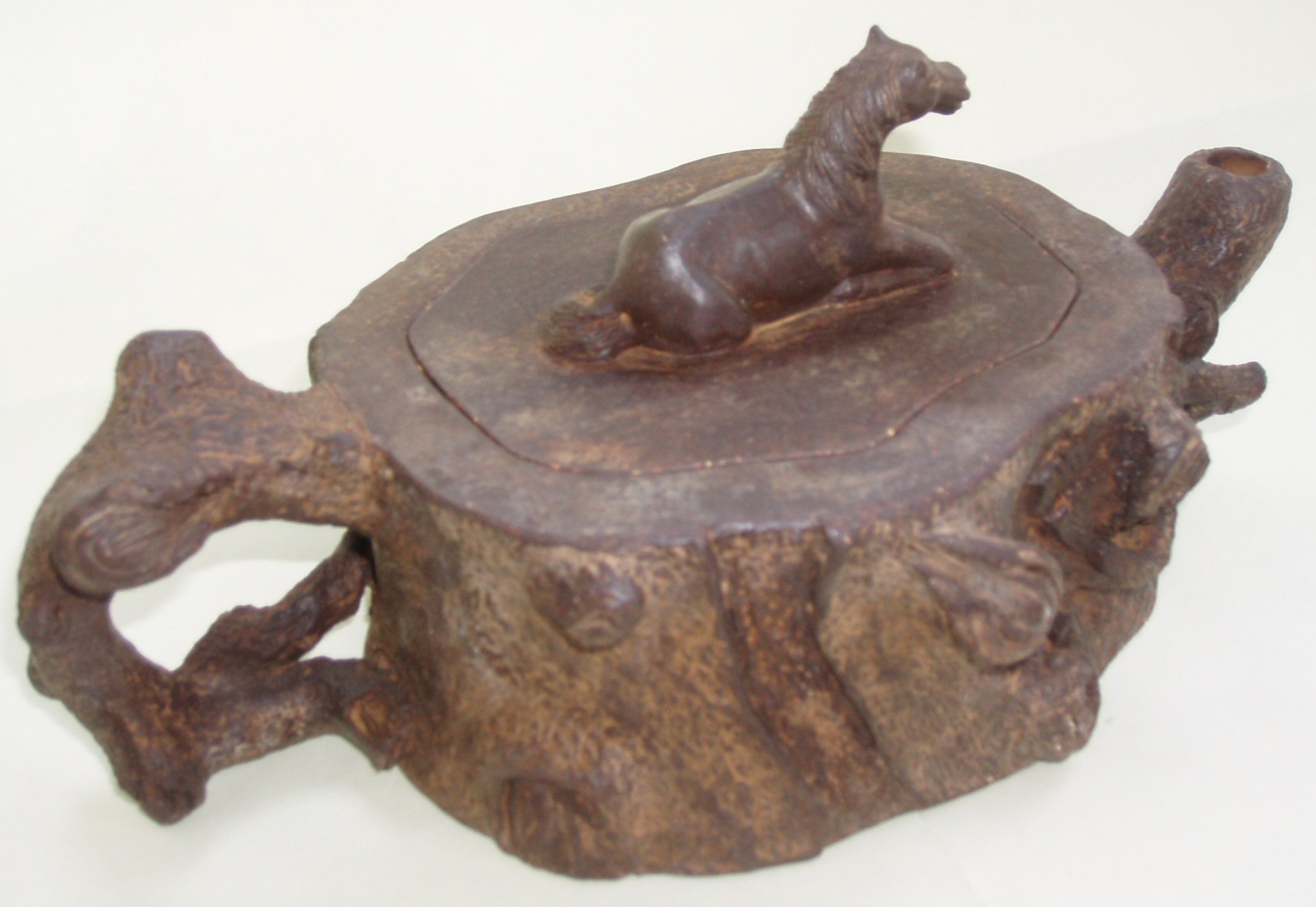
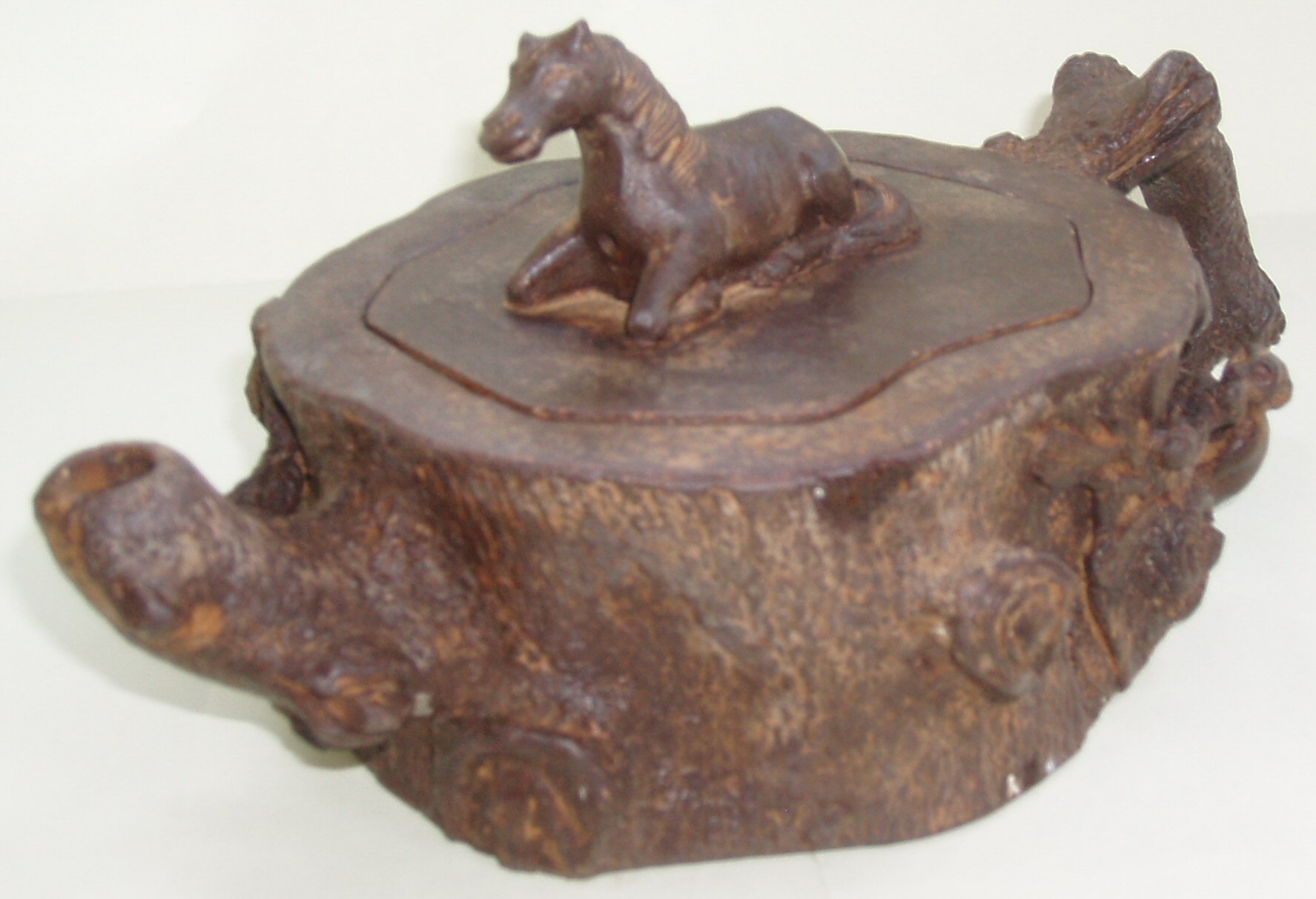
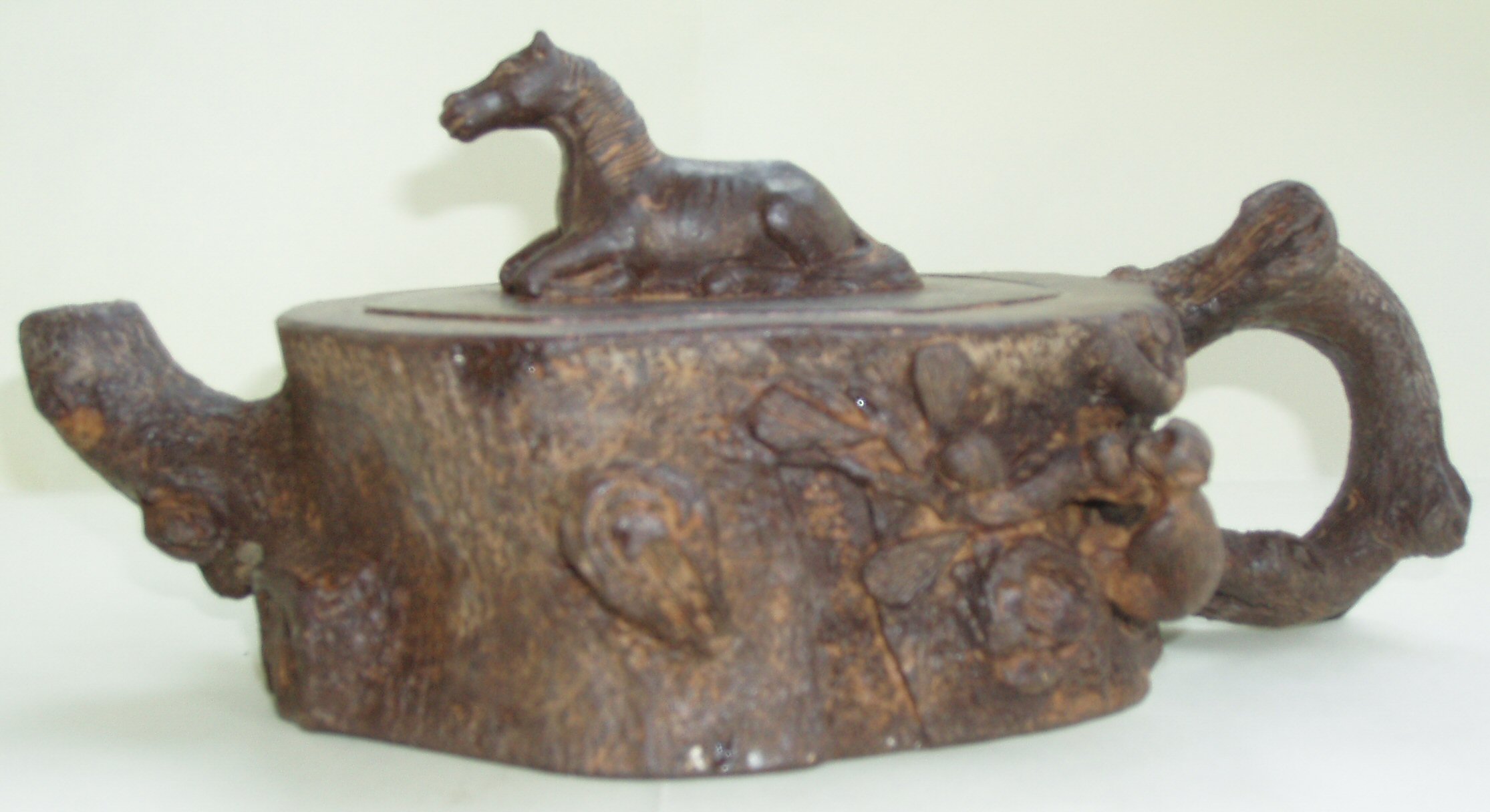

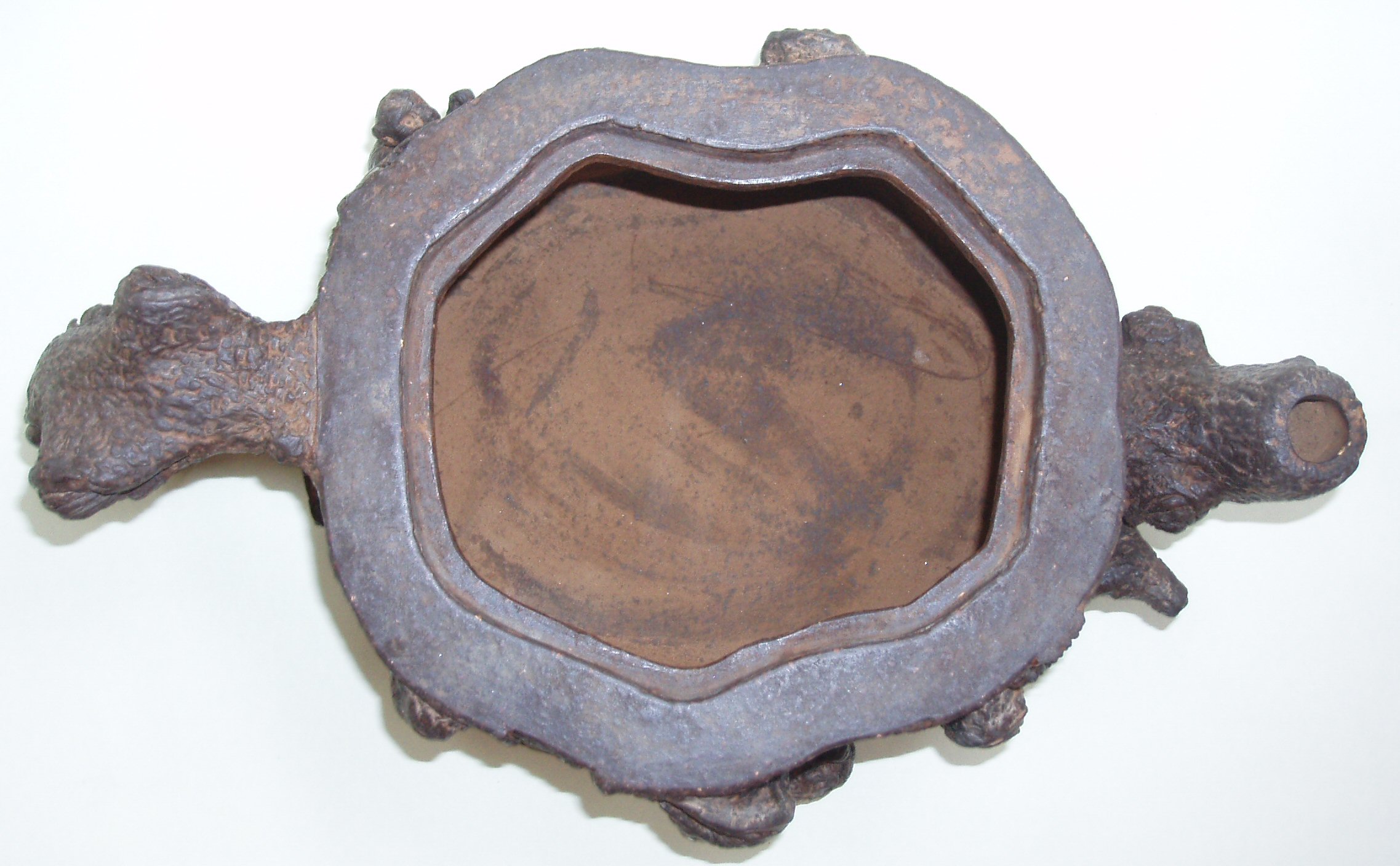
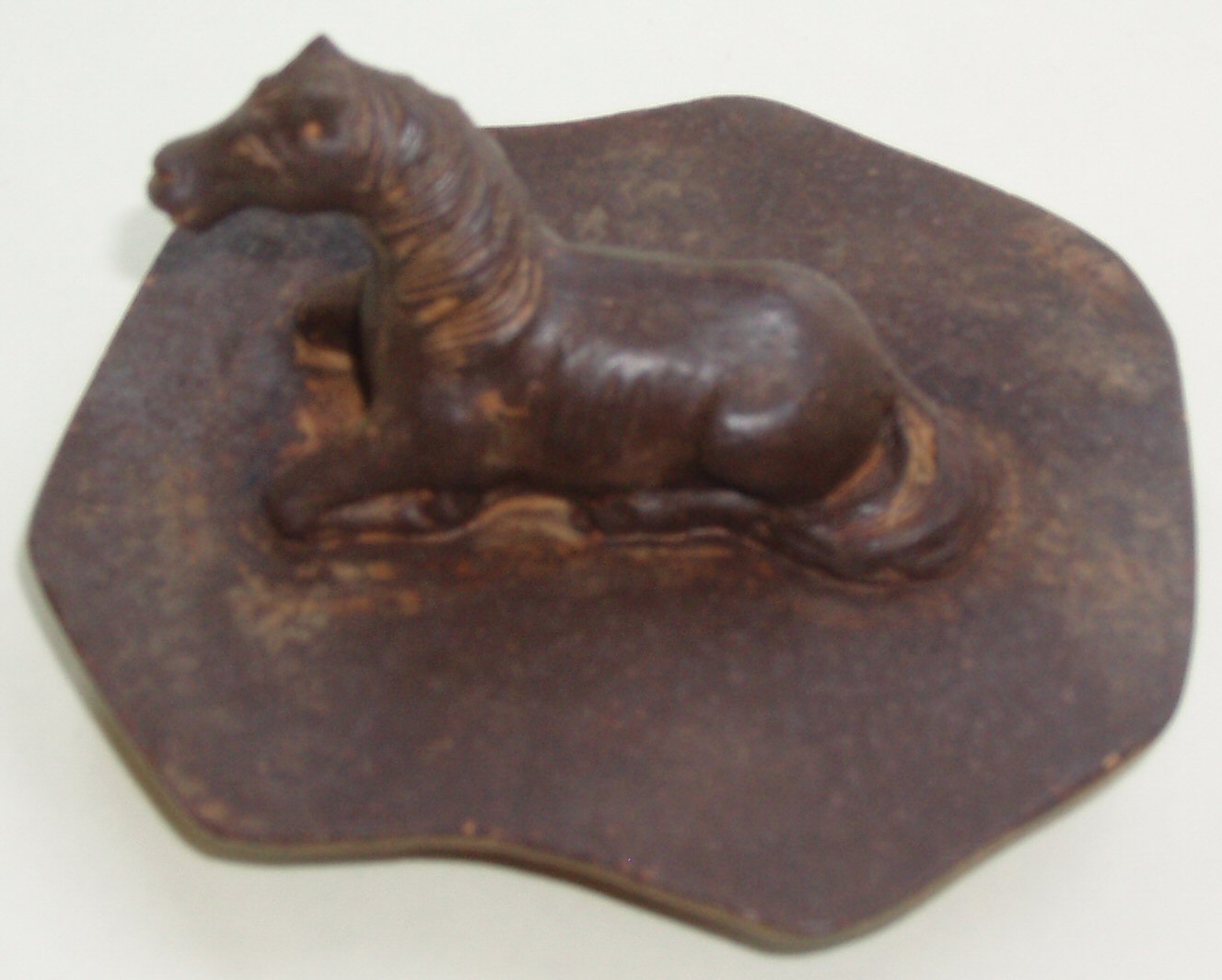
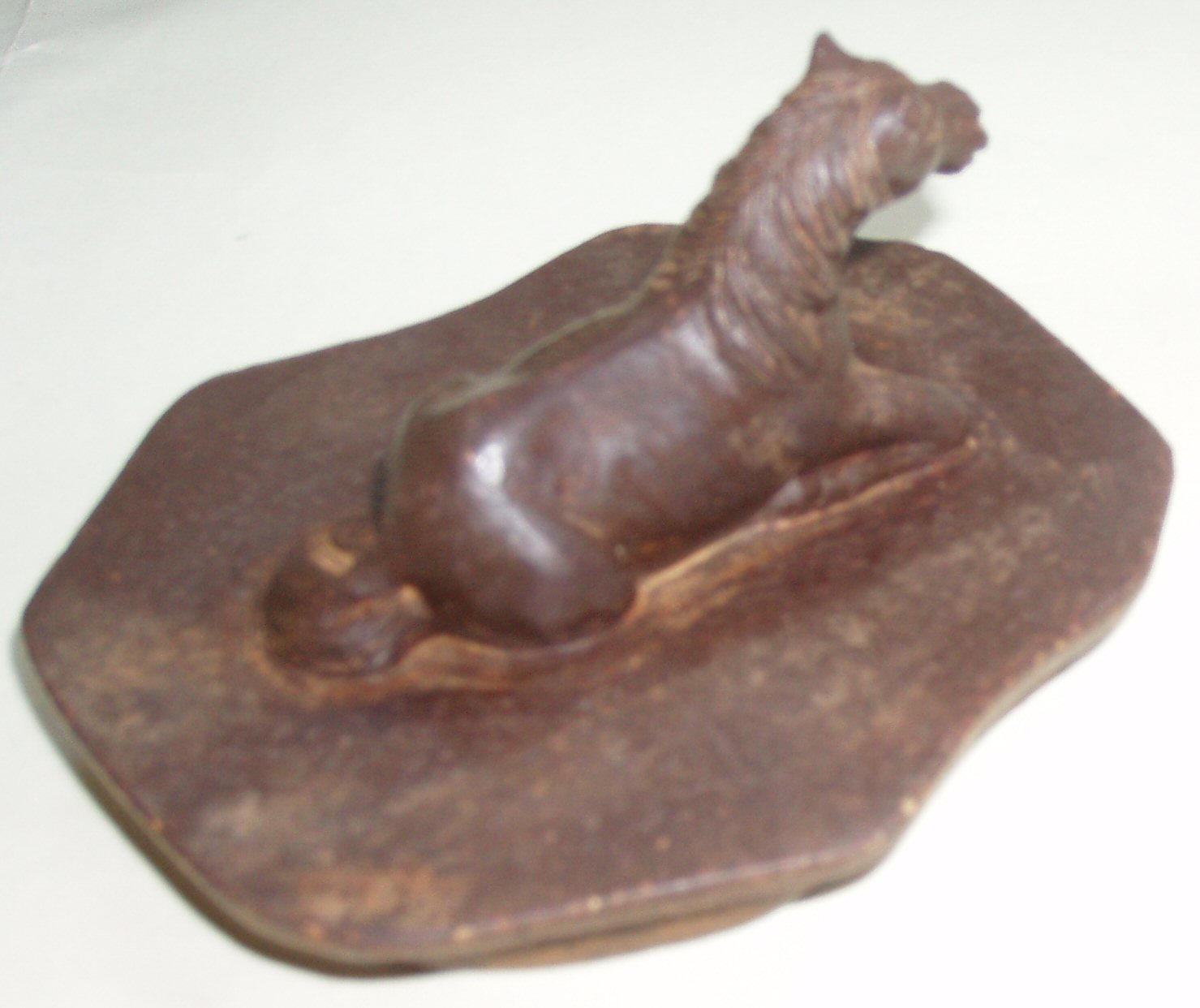
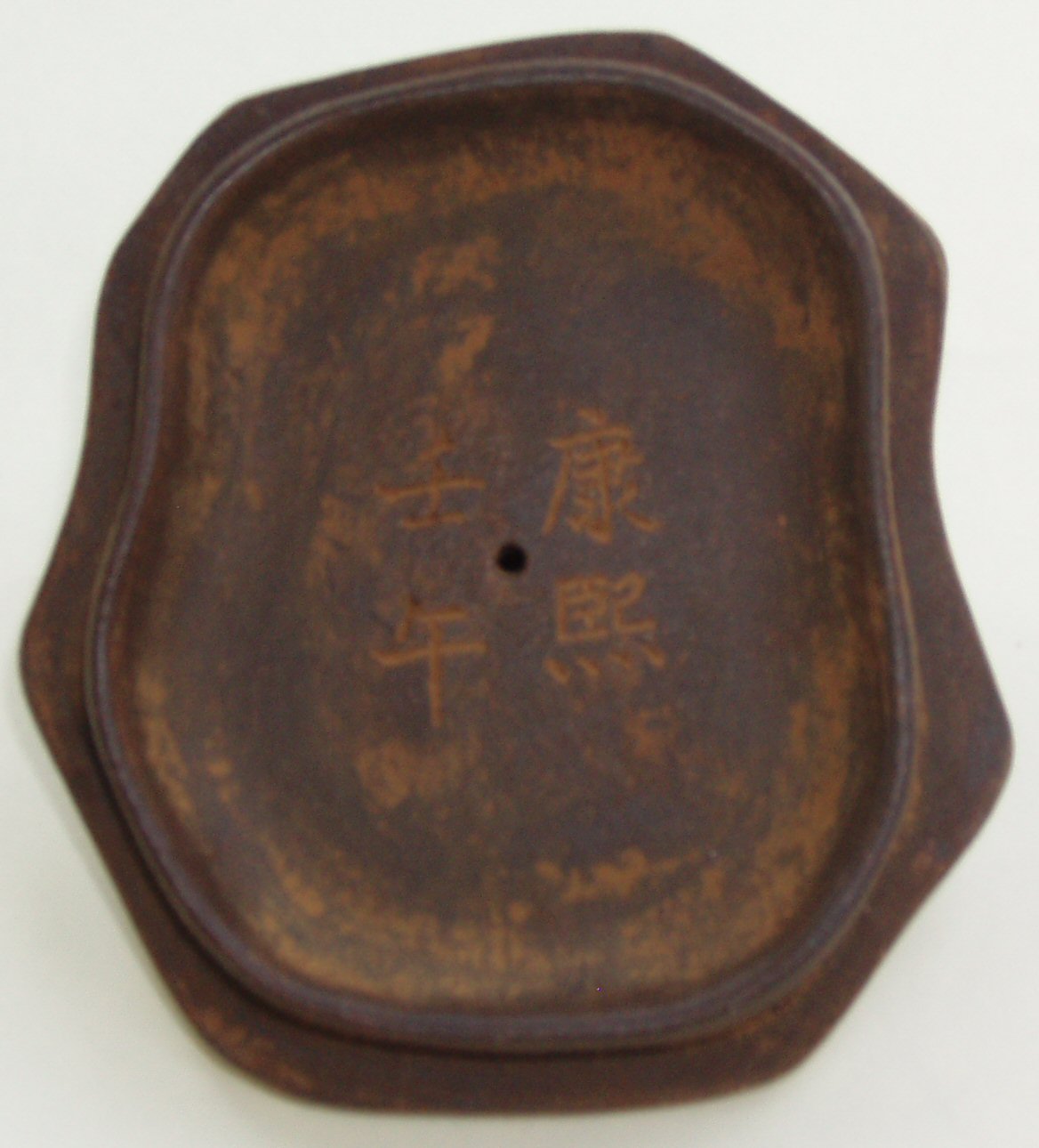
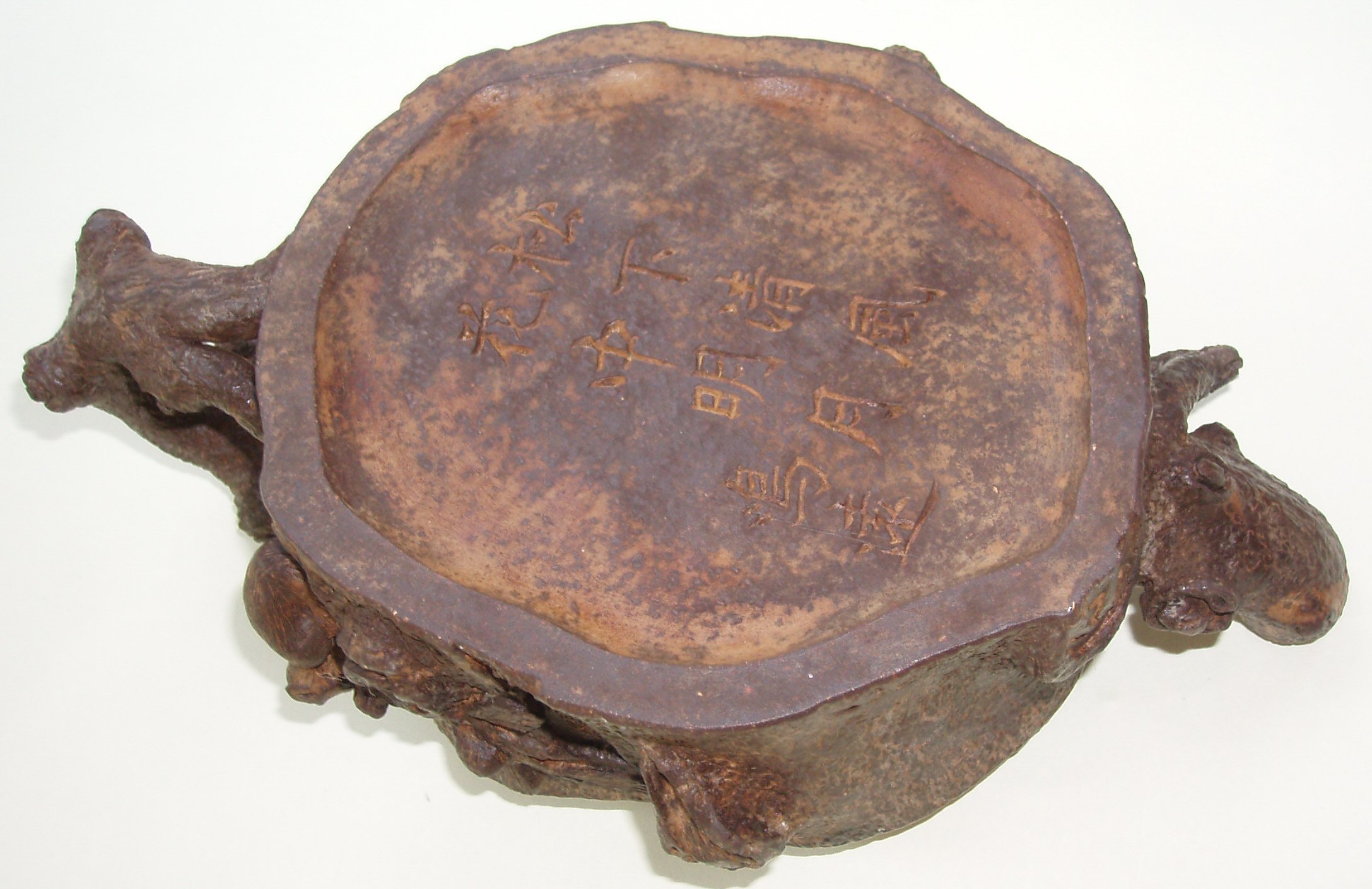
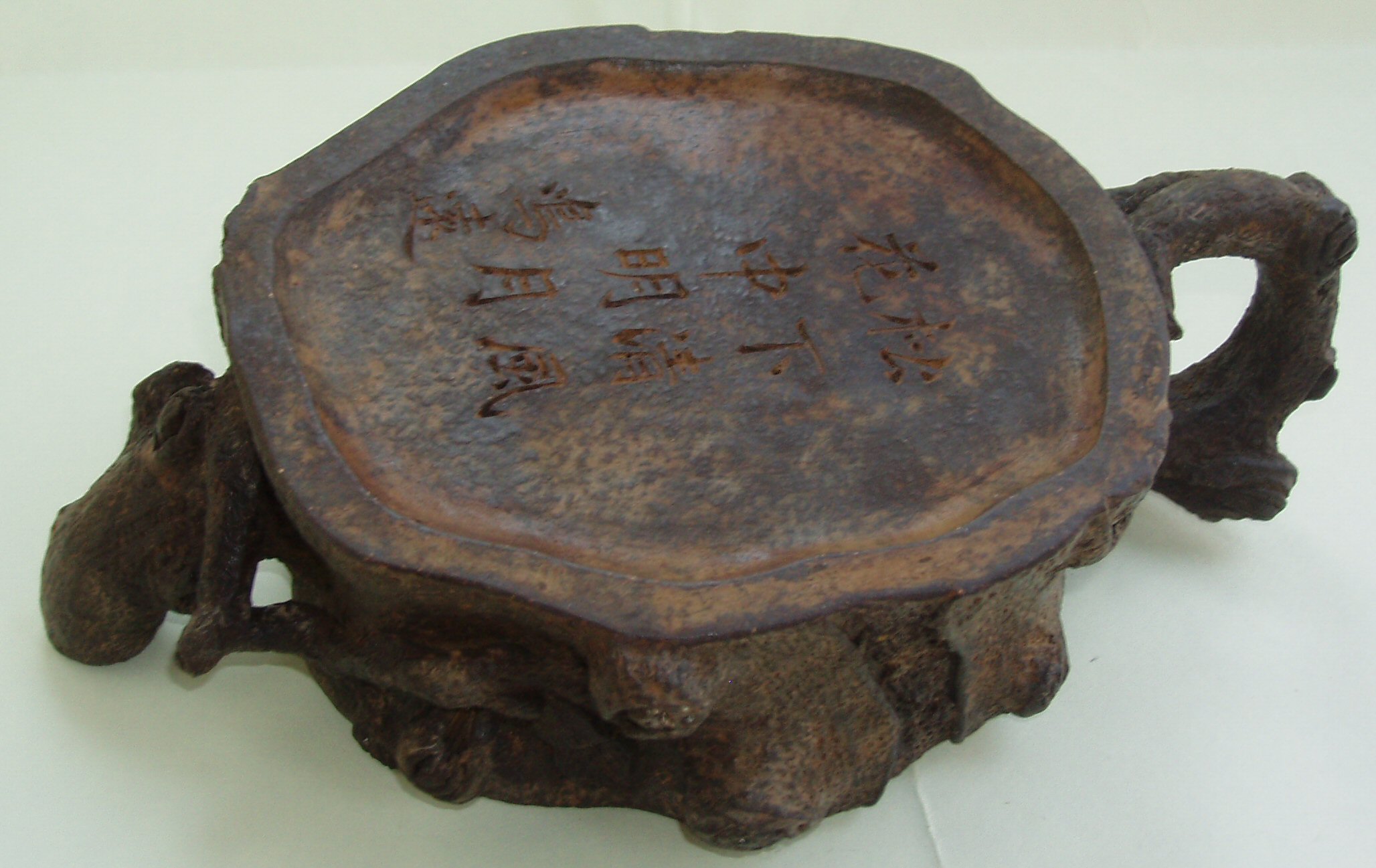
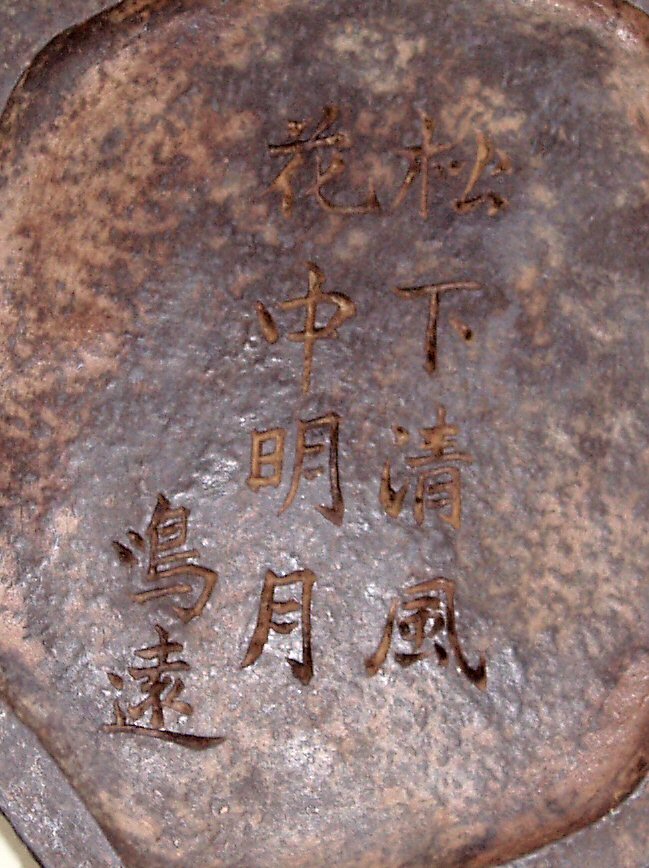
Yixing Purple Clay Teapot by Qing Master Chen Mingyuan (active during 1622--1735)
清代紫砂壺大師陳鳴遠製「樹段卧馬」紫沙茶壺
Based on the Carved Calligraphy on the inside of the cover, this teapot was made in 1702.
此壺製於公元1702年,也就是清康熙四十一年(康熙壬午年)
Chen Mingyuan was the most renowned potter of Yixing zisha (purple clay) teapots during the early Qing period and was equal in fame to the great master Shi Dabin of the late Ming. Although working on a traditional theme, the Three Friends of Winter, the potter, by means of his innovative ideas, produced an altogether new form. His preference for the idyllic rural subjects made his works unique. This teapot, a typical example of Chen's style, is more likely to be authentic.
The potter
has ingeniously made the body of this teapot into a portion of a block of
pine, with a horse sitting on top of the block. The detail of the gnarled bark
and needles of the pine are carefully assimilated. The handle and spout are
shaped into a bent pine branch. Interestingly, Chen made a lid with a sitting horse is a
very exceptional design of Chen's teapots. The
inscription of a poet meaning "cool breeze under a pine tree and bright
moonlight through the flowers" and signed "Mingyuan" on the teapot base is
a description of a very enjoyable scenery. The inscription inside the lid
showed when this teapot was made, which is "Ren Wu year of Kangxi" or
1702.
=================================================================================================
Mr. Cheng Mingyuan (陳鳴遠) is the most famous potting master in early days of Qing Dynasty. It was recorded in 《Yang Xian Famous potters陽羨名陶錄》by Wu Qian (吳騫) in 1786 (Yixing宜興 is call “Yang Xian陽羨 in ancient times). Wu thinks that Cheng Mingyuan’s teapot is the best over the preceding century of his time and he ranked Cheng’s teapots equal to those of another great Ming Dynasty master Shi Da Bing (時大彬). Moreover, the carved Calligraphies on the Cheng Mingyuan’s teapots which were mostly written by famous calligrapher Mr Cao Qian Rang (曹廉讓) made Cheng’s teapots even much more valuable. Since then, this modus operandi has been continued all along as many famous literates, painters, and politicians like to write their epigraph on the purple teapots so as to enhance their artistic values. Some of them even invited potters to make teapots for them which carried their calligraphies. The most famous of this type of teapots is Man Sheng pot (曼生壺)which was made under the cooperation of Cheng Man Sheng (陳曼生) and Yang Peng Nian (楊彭年);Yang Peng Nian made pot first and then epigraphs by famous calligrapher and painter Cheng Man Sheng were carved on the pot.
==================================================================================================
陳鳴遠
字鳴遠,號鶴峰,又號石霞山人,壺隱,清康雍(1622--1735)間宜興紫砂名藝人,是幾百年來壺藝和精品成就很高的名手,其生卒年代不详,据徐秀棠《中国紫砂》考证:大概生于康熙十九年(1680年)。他出生於紫砂世家,所制茶具、雅玩達數十種,無不精美絕倫,他還開創了壺體鐫刻詩銘之風,署款以刻銘和印章並用,款式健雅,有盛唐風格,作品名孚中外,當時有“海外競求鳴遠碟”之說,對紫砂陶藝發展史建立了卓越功勳。(詳見紫砂書籍《壺魂》《壺論》)
制壺技藝精湛全面,又勇於開拓創新。他仿製的爵、觚、鼎等古彝器,工藝精,品位高,古趣盎然。所制茗壺造型多種多樣,特別善於自然型類砂壺的製作,作品有瓜形壺、蓮子壺、束柴三友壺、松段壺、梅幹壺、蠶桑壺等均極具自然生趣,把自然型壺在明人的基礎上,進一步推向藝術化的高度。這些壺式不僅是他的傑出創造,而且成為砂壺工藝上的歷史性造型,為後來的制壺家們廣泛沿用。
他多才多藝,還製作了許多案頭陳設的清供雅玩和文房用具,像生的菱角、扁豆、花生、玉蜀黍、鶿菇、栗子、藕片、荸薺、核桃、白果等等,無不精妙,把果蔬的自然生態,表現的淋漓盡致,惟妙惟肖,再配以契合果蔬肌理的泥色,給人以活生生鮮靈靈的審美感受,令人拍案叫絕。
他還開創了壺體鐫刻詩銘作裝飾,署款以刻名和印章並用,把中國傳統繪畫書法的裝飾藝術和書款方式,引入了砂壺的製作工藝,使原來光素無華的壺體增添了許多雋永的裝飾情趣,也使砂壺更具有了濃厚的書卷氣,再加之詩銘、書款的書法雅健娟秀,富有晉唐筆意,從而把壺藝、品茗和文人的風雅情致融為一體,極大的提高了砂壺的藝術價值和文化價值,成為真正的藝術品進入了藝術殿堂,這是陳鳴遠在壺藝發展史上建立的卓越功勳。
傳世鳴遠作品除仿古諸器外,著名的有:甜瓜壺,原名南瓜壺,是鳴遠的一件代表作,壺身鐫有“仿得東陵式,盛來雪孔香”詩句,刻款楷書“鳴遠”,鈐“陳鳴遠”陽文篆書方印,今藏南京博物院。四足壺,壺身銘“且飲且讀,不過滿腹”,今藏上海博物館。旋渦紋瓜形壺,今藏香港茶具文物館。蓮子壺,壺身銘“資爾清德,煩暑咸滌,君子友之,以永朝夕。”今藏蘇州市文物商店。松段壺,今藏宜興陶瓷陳列館。調殺蠶桑壺,今藏香港中文大學文物館。還有筍型水盂,也是鳴遠的代表作品,今藏南京博物院。其他還有一批清供雅玩,由國內外文搏機構及私家收藏。
Click Here to See Other Teapots
Click Here to Go Back to Homepage